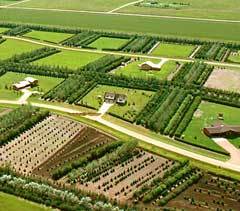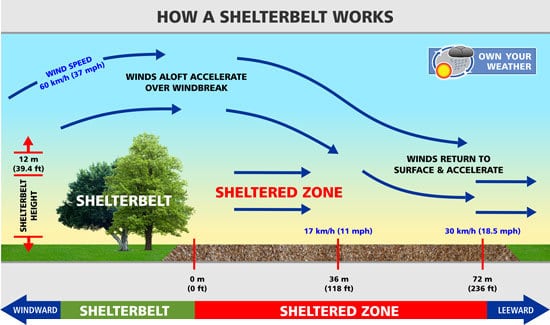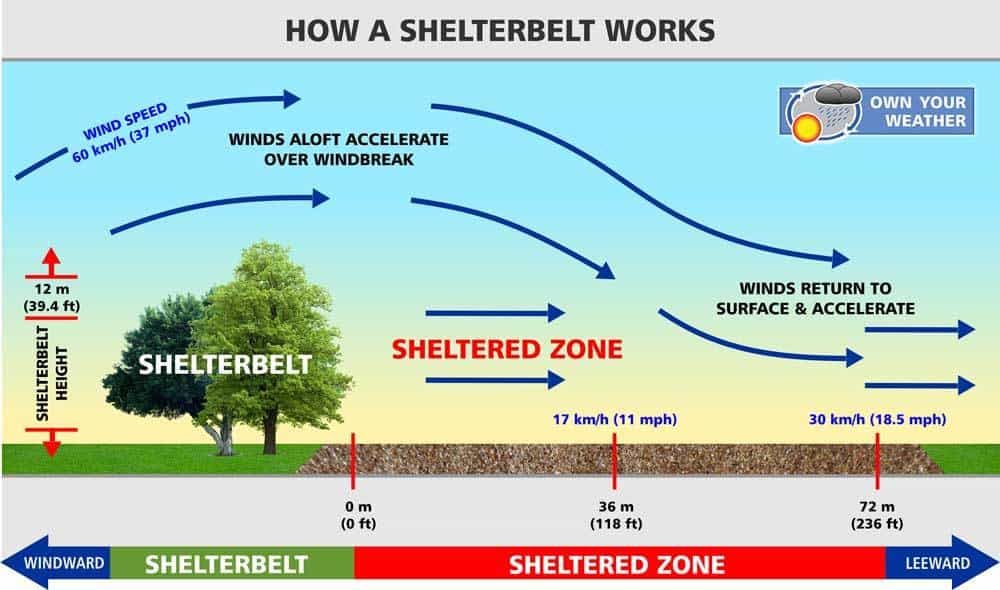Defining A Shelterbelt And How It Works

Air movement plays a crucial role in the development of most weather conditions. At ground level, though, strong winds can adversely affect surface conditions. Shelterbelts help to limit its damaging effects.
A shelterbelt is defined as a vegetation barrier, typically consisting of lines of trees and shrubs grown to restrict the damaging effects of strong wind. It is used in agriculture to protect crops and livestock and in environmental protection, guarding against erosion, such as topsoil depletion.
One can see the impact constant wind movement has on the environment through wind erosion occurring in different regions. Along the coast, exposed sand dunes retreat inland due to wind activity, while topsoil is removed from fertile land in increasingly arid territories.
Wind can also have a negative impact on agriculture. It can damage or even destroy entire crops and also harm livestock that is sensitive to extreme temperatures.
These are just a few examples where persistent wind activity is not only unwelcome but also damaging with potentially huge implications. Here, relatively simple but very effective human innovation comes into play. It is called a shelterbelt.
Shelterbelts are used throughout the world as an artificial barrier to protect against the harmful effects of wind activity.
What Is A Shelterbelt?
Also known as windbreaks, shelterbelts serve a number of different purposes. The main objective always remains the same, though, which is to protect selected areas against potentially damaging wind forces.
Before describing how it works in more detail, one first needs to define what precisely a shelterbelt is:
Shelterbelt Definition

A shelterbelt is a barrier of vegetation, which usually consists of lines of trees and shrubs created to restrict the damaging effects of wind activity. It is used in agriculture to protect crops and livestock and in environmental protection by guarding against erosion through topsoil depletion.
The main goal and purpose of shelterbelts are to reduce wind velocity dramatically. It accomplishes this task by planting one or more lines of vegetation in the path of a prevailing wind to protect a selected area.
The line of vegetation usually consists of a combination of trees and shrubs to be the most effective. Depending on the specific goal, several lines of vegetation can be planted to provide optimum protection.
The protected area downwind from the windbreak can vary from experiencing very little to no wind, based on the density and number of lines of the protective barrier. The windless region created by a shelterbelt is known as a wind shadow.
How A Shelterbelt Works
As stated in the previous section, a shelterbelt protects a specified area by significantly reducing or eliminating the wind speed over the protected region. The protected area can be a field of crops, livestock, or area of land that is vulnerable to wind erosion.

Illustration showing how a shelterbelt works. Click on image for a larger view.
The illustration above will assist in illustrating how a typical shelterbelt works in practice. Although the figures and measurements will differ from one type of windbreak to another, the fundamental principles remain the same.
The following fundamentals provide a thorough overview of the process through which a shelterbelt functions.
- A shelterbelt is situated upwind (on the windward side) from the protected area.
- The windbreak is situated perpendicular (at a 90° angle) to the wind direction to provide maximum protection.
- 3The trees and shrubs used in shelterbelts are semi-permeable, which is crucial. A solid impermeable windbreak causes a sudden disruption of the wind flow. It results in turbulent instead of calm air on the leeward side of the barrier.
- 4As the moving air reaches the windbreak, pressure builds up on the windward side of the barrier. The majority of air is forced over the top of the shelterbelt. Some escape along the edges while the remaining air filters through the trees and shrubs.
- 5The wind traveling over the top of the windbreak accelerates to cause a jet of fast-flowing air. It travels aloft for a distance before descending back to the surface.
- 6The distance the air travels before dropping down is approximately 3-5 times the height of the shelterbelt.
- 7As a result, a calm area of low-pressure gets created on the leeward side of the windbreak. The length and amount of air movement in this sheltered location depend on the height and density of the shelterbelt.
- 8After descending back to the ground, the air that traveled over the sheltered region regains momentum and speed.
- 9The air pressure at the surface also returns to normal at this point. It acts as a high-pressure buffer to further limit the movement of air within the protected area behind it.
Although differing in size and height, all shelterbelts form and function in the way describes in these steps.
The Purpose Of A Shelterbelt
As mentioned earlier in this post, a shelterbelt is used for a number of different purposes. The most notable application is in the agricultural sector to protect crops and livestock, but also in the environment to protect against wind erosion.

The following list provides a concise summary of the primary applications of shelterbelts used for protecting and shielding different areas:
(* Thermal neutral zone is the temperature at which an animal experiences optimal health and performance.)
Conclusion
As this post clearly illustrated, shelterbelts or windbreaks are a simple but effective means of protecting against the damaging effect of prevailing winds. They also have a wide range of applications, varying from the practical to the aesthetical.
This article illustrated what a shelterbelt/windbreak is, how it works, as well as highlighted its various uses.
Never miss out again when another interesting and helpful article is released and stay updated, while also receiving helpful tips & information by simply following this link .
Until next time, keep your eye on the weather!

